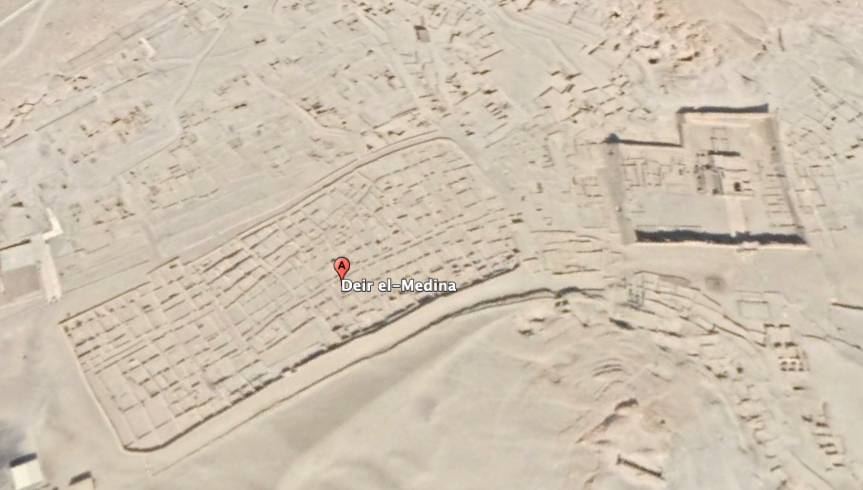Jennifer Cromwell

Deir el-Medina in western Thebes was home to a community of skilled workers, who were responsible for constructing and decorating the royal tombs of the period, in the Valley of the Kings and the Valley of the Queens. One draftsman from the village, Prehotep, perhaps after a particularly hard shift, just wanted to relax with a beer. However, with no beer in his house, he wrote to his boss, the scribe Qenhirkhopeshef, to try to convince him to invite him for a drink. Prehotep accuses Qenhirkhopeshef of never wanting to socialise with him, only asking for him when there was work to be done, treating him like a donkey – the main working animal of the village (see more about donkeys in this story).
“The draftsman Prehotep communicates to his superior, the scribe of the Place of Truth Qenhirkhopeshef, in life, prosperity, health!
What’s the meaning of this negative attitude that you are adopting toward me? I’m like a donkey to you. If there is work, bring the donkey! And if there is fodder, bring the ox! If there is beer, you never ask for me. Only if there is work (to be done), will you ask for me.
Upon my head, if I am a man who is bad in (his) behaviour with beer, don’t ask for me. It is good for you to take notice in the Estate of Amon-Re, King of the Gods, life, prosperity, health.
P.S. I am a man who is lacking beer in his house. I am seeking to fill my stomach by my writing to you.” (translation by Edward Wente)

Maybe Prehotep could not hold his drink – though, ancient beer was pretty low in alcohol and so it would have taken a lot of beer to make him drunk and disorderly. But, maybe the problem was his pushy boss.
Qenhirkhopeshef is the best-known scribe of the community, referred to here by the term ‘Place of Truth’ (set ma’at), which encompasses both the village and the Theban necropolis. In addition to his official work as village scribe, we have a glimpse into his interests thanks to the survival of his library, which he left to his young wife Naunakht. This library included the only known dreambook from the period (P.Chester Beatty III, in the British Museum: BM EA 10683), on the back of which Qenhirkhopeshef wrote a draft letter and a portion of the account of the victory of Ramesses II over the Hittites at Kadesh. Another text in the collection is a charm, probably folded and worn as an amulet, against a demon shekek. But what of his professional life and Prehotep’s strong words?
Prehotep makes it clear that Qenhirkhopeshef used him for his own purposes, putting him to work most likely on the building of the scribe’s own tomb. And this is not the only example of Qenhirkhopeshef enjoying this perk. In an attendance sheet dated to year 40 of the reign of Rameses II (ca. 1,239 BCE), the workman Anuy is noted as being absent because he was busy “fetching stone for Qenhirkhopeshef” – and several further ostraca record similar situations. Other texts from the village paint the scribe in a particularly bad light: he is accused of taking bribes in a papyrus now in the British Museum (“Papyrus Salt 124”, BM EA 10055) and in an ostracon written by one Rahotep. In the latter, Rahotep provides services (hair shaving) and goods (fabric and yarn) so that Qenhirkheopeshef will conceal his misdeeds.
In this light, Prehotep’s accusation has a ring of truth, even if he was using the scribe’s negative reputation for his own ends. Sometimes, you just want to join your co-workers for a drink, and if your boss can provide the beer, then even better!

Technical Details
Provenance: Deir el-Medina, Egypt
Date: Mid-Dynasty 19 (ca. 1,250 BCE)
Language: Ancient Egyptian (Late Egyptian)
Collection: Institut français d’archéologie orientale, Cairo (O.IFAO 800)
Designation: O.DeM303 (see the Deir el-Medina database for more details)
Bibliography: Jaroslav Černý (1939), Catalogue des ostraca hiératiques non littéraires de Deir el Médineh. Vol. 4 (Nos 242 à 339) (Cairo), p. 16 + pl. 18; Jaroslav Černý (1973), A Community of Workmen at Thebes in the Ramesside Period (Cairo), p. 337; Kenneth A. Kitchen (1982), Pharaoh Triumphant: The Life and Times of Ramesses II, King of Egypt (Warminster), p. 194; Edward F.Wente (1990), Letters from Ancient Egypt (Atlanta), p. 149 [no. 204]
One thought on “A Stingy Boss and a Lack of Beer”